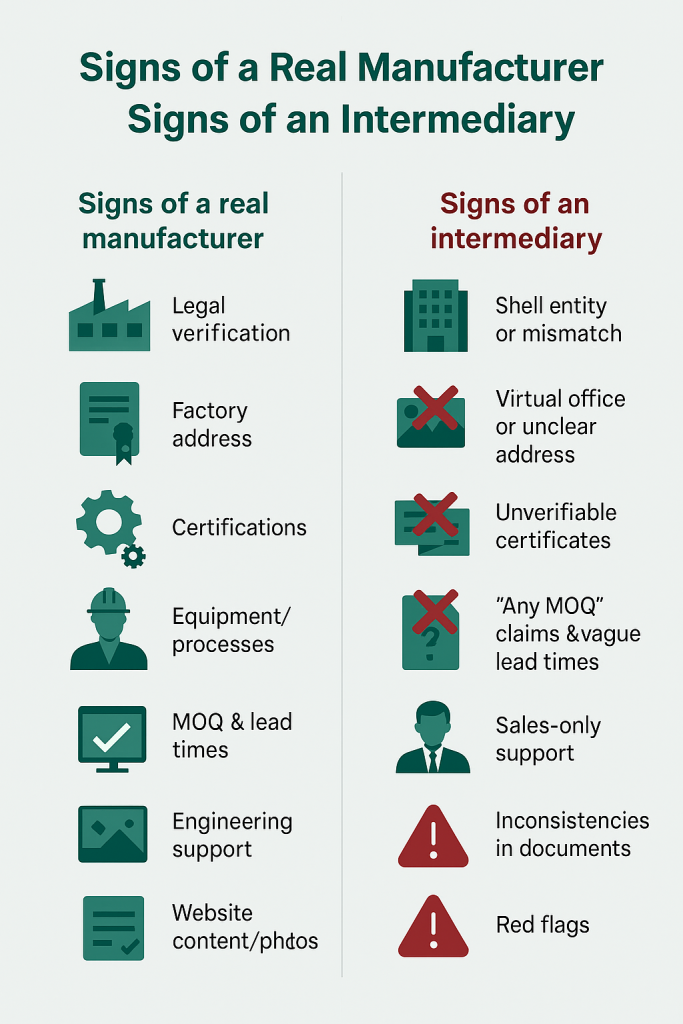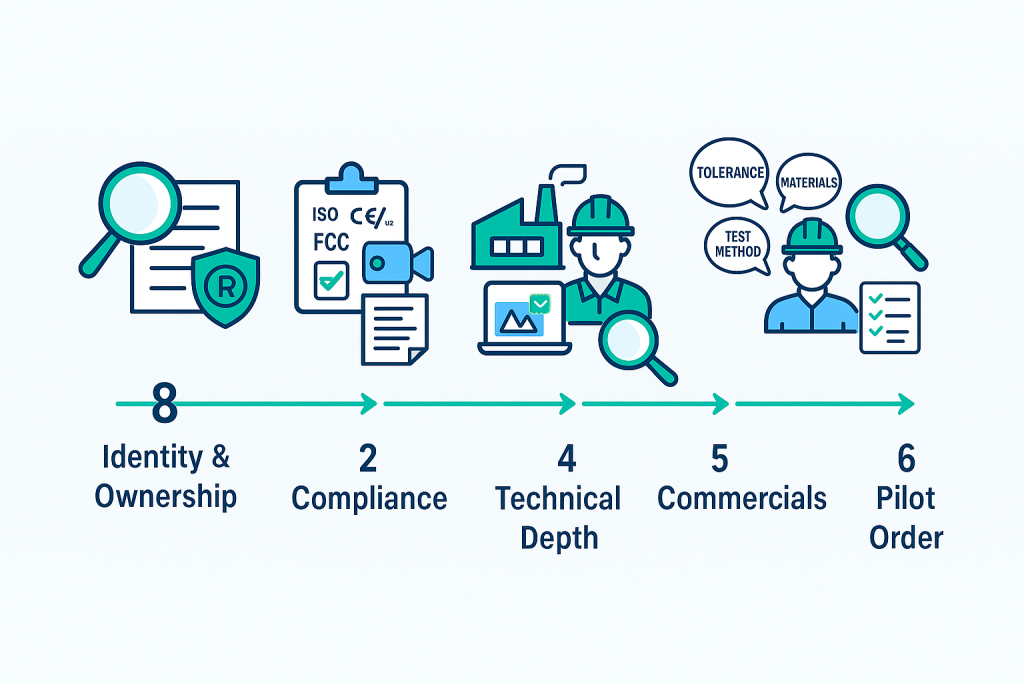How to Distinguish a Real Manufacturer from an Intermediary When Shopping Online
August 16, 2025

Buying direct from a true manufacturer can cut costs, improve quality control, and speed up custom work. But online, manufacturers, trading companies, wholesalers, and dropshippers often look the same. This guide gives you a practical, proof-based method to tell them apart—fast.
TL;DR: The 3-Step “Proof, Process, Paperwork” Test
Start with a quick triage. If a site fails any one of these, proceed with caution.
- Proof: Can they show credible evidence of production (factory address, equipment, in-house QC, production team, OEM/ODM)?
- Process: Do MOQs, lead times, and engineering support match a factory’s reality (not a reseller’s)?
- Paperwork: Do legal records, compliance certificates, and identifiers (VAT/EIN, ISO, CE/FCC/UL, GS1 barcodes, trademarks) trace back to them?
If all three align, you’re likely dealing with a real manufacturer.
Why distinguishing matters
A real manufacturer usually gives better unit economics at scale, tighter quality control, and faster customizations. An intermediary can be useful for small runs or multi-category sourcing, but you’ll pay extra margins, face inconsistent quality, and rely on second-hand information for compliance and warranty. Knowing which is which lets you set the right expectations (and contracts).
Evidence on the website: signals that actually prove things
Look for specific, verifiable details—not vague claims.
- Factory footprint: Street-addressed facilities, floor area, machinery lists, process photos/videos, and in-house lab/QC descriptions.
- People & roles: Named engineers, production managers, and quality leads; a careers page hiring machinists, operators, SMT techs—not only sales reps.
- Process depth: BOM materials, tolerances, certifications mentioned by scope (e.g., “Design & manufacture of…”), and QC stages tied to standards.
- Narrow specialization: Focused product families and deep technical pages (drawings, CAD notes, maintenance specs) beat “we sell everything” catalogs.

The table you can actually use
| Check | What to do | Likely manufacturer signal | Likely intermediary signal |
|---|---|---|---|
| Legal entity | Look up company registration, VAT/EIN, business registries in the firm’s country. | Records match site name, address, and activity (manufacture/production). | Recent shell entity, mismatched addresses, “virtual office”. |
| Factory address | Verify on maps/street view; request a live video walk-through. | Industrial site, loading bays, signage; floor space consistent with output. | Coworking or residential address; no site visit possible. |
| Certifications | Ask for ISO 9001 scope, CE/FCC/UL file numbers; verify in accreditors’ directories. | Certificate holder’s name matches vendor; scope includes manufacture. | Certificates belong to someone else, wrong scope, or unverifiable. |
| Barcodes/GTIN | Check GS1 ownership of brand/prefix. | Brand’s GS1 data points to the same company. | GTINs registered to a different company (or none). |
| Trademarks | Search brand in TM databases (WIPO/EUIPO/TMview). | Trademark owner is the same entity at the same address. | Mark owned by another party; seller has only “authorization”. |
| Product range | Scan catalog breadth and depth. | Tight family, deep specs, custom options. | Hundreds of unrelated SKUs; generic descriptions. |
| MOQ & lead time | Ask for MOQ by customization level; ask capacity numbers. | Higher MOQs for custom parts; lead times tied to line capacity. | Any MOQ you want; vague, shifting lead times. |
| Engineering support | Ask technical questions (tolerances, materials, test methods). | Precise answers from engineers; sample control plans. | Sales answers only; “we’ll ask factory” repeatedly. |
| Warranty/RMA | Request RMA workflow and failure analysis examples. | In-house FA reports; clear RMA addresses and timelines. | Returns go to “partner warehouse”; no FA capability. |
| Pricing behavior | Test volume tiers and change requests. | Transparent cost drivers; stable quotes tied to materials and process. | Price swings without explanation; pushes prepayment before tech details. |
A step-by-step due-diligence workflow (works for B2B and advanced B2C)
Follow these steps; you’ll filter 80–90% of risky suppliers in days, not weeks.
- Identity & ownership
- Match website name, legal company name, and registered address.
- Confirm VAT/EIN (or local equivalents).
- Optional: check the D-U-N-S number (Dun & Bradstreet) for a quick credit/identity snapshot.
- Brand & product ownership
- Search the brand in national/international trademark databases.
- For packaged goods, check GS1 (UPC/EAN/GTIN) ownership for the brand/prefix.
- Compliance trail
- Request ISO 9001/14001 certificate with scope that includes manufacturing.
- For regulated goods, ask for CE DoC, FCC ID, or UL file number (as applicable) and verify them in the official directories.
- Ask for supporting lab reports (test house, date, model, standard).
- Production reality check
- Ask for a 10–15 minute live video walk-through: materials receiving → production → QC → packing.
- Request production photos with today’s date/PO number on a whiteboard to avoid stock photos.
- Probe capacity: lines, shifts, monthly units, bottlenecks.
- Technical depth
- Send a short spec sheet and ask three precise questions (e.g., tolerance, finish, test method).
- Ask for a sample control plan or PFMEA summary for your SKU type.
- Commercials
- Compare quoted MOQs and lead times by customization level.
- Request tiered pricing with material and process levers called out.
- Confirm RMA/Warranty procedures and failure analysis capability.
- Pilot before commitment
- Place a small, instrumented pilot order with measurable acceptance criteria.
- Inspect incoming goods (AQL), document defects, and review their corrective action.

Marketplace reality: reading signals on platforms
Marketplaces blur lines between factories and traders. Here’s how to read them.
- Business type vs reality: Profiles may show “Manufacturer & Trading”; judge by catalog focus, factory content, and engineering replies.
- SKU focus: Source manufacturers usually cluster around a narrow family (e.g., only injection-molded organizers). Traders list unrelated categories.
- Certificates & audits: Favor suppliers whose certificates and factory audits name the same company as the storefront.
- OEM/ODM confidence: Real OEM/ODM can explain tooling, DFM, and change control; traders repeat marketing phrases.
Red flags that scream “intermediary”
- “We can make anything” catalogs with inconsistent specs.
- Certificates without file numbers, wrong company names, or missing test reports.
- Returns routed to a different company/country than the seller.
- Only sales contacts, zero production or quality contacts.
- Prices change wildly with no explanation tied to materials or process.
- Reluctance to show the factory on live video or to share capacity numbers.
What manufacturers typically look like
- Focused product lines, deep spec pages, and process transparency.
- In-house or formally contracted QC/lab capabilities.
- OEM/ODM documentation (tooling ownership, DFM notes, ECN/change logs).
- Career postings for production and engineering roles.
- Stable pricing tiers linked to material and throughput, not guesswork.
What intermediaries often look like
- “Everything store” catalogs, stock photos, and generic descriptions.
- Certificates that don’t verify or belong to someone else.
- No factory walk-throughs, no production roles, only responsive sales chat.
- MOQs and lead times that magically fit any buyer’s request.
- Warranty handled by “partner warehouses” with no root-cause analysis.
Buyer checklists you can copy
Documents to request (and verify):
- Legal: registration extract, VAT/EIN (local equivalent).
- Ownership: trademark registration for the brand you’ll buy; GS1 prefix/GTIN ownership for the barcode on packaging.
- Quality: ISO 9001 certificate with scope, recent audit summary.
- Safety/Regulatory (as applicable): CE Declaration of Conformity + test reports; FCC ID grant and test reports; UL file number; material certificates.
- Operations: capacity statement (lines, shifts, monthly units), lead time ladder, RMA workflow.
Questions for your first call:
- What’s your monthly capacity for this exact product family?
- What’s your typical first-article lead time and tooling ownership policy?
- Which standards do you test to, and where are tests performed?
- Can we set up a 10-minute live video walk-through this week?
- Who is the engineering contact for DFM and change control?









